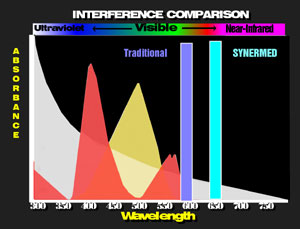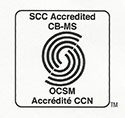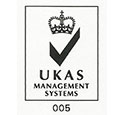Cholesterol
 |
 |
 |
|
-
-
-
- Liquid-Stable Ready-to-Use Reagent
- Superior for HDL Cholesterol
- Effects of Lipemia, Bilirubin, and Hemolysis Minimized
- High Sensitivity
-
-
Signal to Noise Ratio
The Synermed® cholesterol methodology enhances signal to noise ratio as compared to traditional automated methods in two ways. First, the chromophore produced has more than twice the molar absorbance compared to the most commonly used automated methods. Second, the shift in wavelength to the infrared diminishes absorbance due to lipemia, bilirubin and hemoglobin. The overall signal to noise enhancement is about 700% for lipemia. Hemoglobin and bilirubin produce no chromatic interference in the method.
The improved performance relative to chromatic substances is dramatic in the application of the method to HDL cholesterol.
Analytical Range
Most applications of this procedure have been found to be linear to 24 mmol/L (929 mg/dL).
Expected Values
The recommendations of the Adult Treatement Panel of the National Cholesterol Education Program for Classificaiton of Patients is as follows:
| Risk Classification Total Cholesterol in Blood | |
| Desirable | <5,17 mmol/L (<200 mg/dL) |
| Borderline High | 5.17-6.18 mmol/L (200-239 mg/dL) |
| High | >6.20 mmol/L (>240 mg/dL) |
Special Performance Characteristics
- The Synermed cholesterol methodology was correlated to a widely accepted enzymatic cholesterol method. The calculated linear regression on 47 samples ranging from approximately 2.5 mmol/L to 16 mmol/L (97-620 mg/dL) with Synermed results on the Y-axis was: Y = 0.94X + 0.07 mmol/L (2.7 mg/dL) with a correlation coefficient of 0.997.
- The sensitivity of the procedure is such that an absorbance change of 0.001 will detect as little as 0.018 mmol/L (0.7 mg/dL) of cholesterol.
- The average within run precision of the method was determined by assaying 36 samples of quality control material at two levels of cholesterol concentration on an automated analyzer which provided the following results:
Mean SD CV 4.0 mmol/L (155 mg/dL) 0.038 (1.5) 0.96% 5.7 mmol/L (221 mg/dL) 0.043 (1.7) 0.76% - The run to run reproducibility of the method as applied to an automated analyzer was determined from the values obtained by 5 replicate analyses of quality control material assayed over a 22 batch period.
Mean SD CV 3.02 mmol/L (117 mg/dL) 0.04 (1.5) 1.2% 7.63 mmol/L (295 mg/dL) 0.11 (4.3) 1.4%
Product Packaging and Storage
| Cat No. | Product Name | Packaging | Package Volume (mL) | Storage |
| IR060-X | Cholesterol | 1x250 mL + 1x100 mL | 350 | 0-4° C |
| IR060 | Cholesterol | 3x250 mL + 3x100 mL | 1,050 | 0-4° C |
| IR061-L | Cholesterol Chromogen | 6x1000 mL | 6,000 | 0-4° C |
| IR062-L | Cholesterol Enzyme | 6x500 mL | 3,000 | 0-4° C |
| IR060-911 | Cholesterol | 6x50 mL + 3x40 mL | 420 | 0-4° C |
| IR060-WK | Cholesterol | 3x25mL + 3x10mL | 105 | 0-4° C |
Connect with us
Certifications
 |
 |
 |
 |
||

